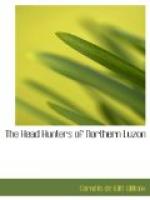Gradually Mr. Worcester satisfied some rancherias, at least, that had been open enemies for generations, whose men, in Mr. Worcester’s graphic expression, had never seen one another except over the tops of their shields, that nothing was to be gained in the long run by this secular warfare; and his purpose in bringing the clans together is to make them know one another on peaceful terms, to show them that if rivalry exists, it can find a vent in wrestling, racing, throwing the spear, in sports generally. And they take naturally to sports, these highlanders. Success has crowned Mr. Worcester’s efforts; in witness whereof this very concourse of Banawe may be cited, where over 10,000 persons, mostly unarmed, mingled freely with one another without so much as a brawl to disturb the peace.
Two years ago people would not go to Mayoyao from Banawe, through their own country, save in armed groups of ten to twelve; now women go alone in safety. And it is a significant fact that the Ifugaos are increasing in numbers. Of course, this particular sub-province is fortunate in having as its governor a man of Gallman’s stamp. But it is generally true that village warfare is decreasing, and that travel between villages is increasing. These Ifugaos ten years ago had the reputation, and deserved it, of being the fiercest head-hunters of Luzon. Gallman has tamed them so that to-day they have abandoned the taking of heads. Now what has been done with them can be done with others.
At Banawe we saw more examples of native arts and crafts than we had heretofore. For example, the pipe is smoked, and we saw some curious specimens in brass, much decorated with pendent chains; others were of wood, some double-bowled on the same stem. Some of the men wore helmets, or skull-caps, cut out of a single piece of wood. Other carved objects were statuettes, sitting and standing; these are anitos, frequently buried in the rice-paddies to make the crop good; besides, there were wooden spoons with human




